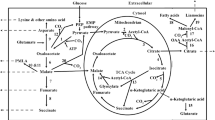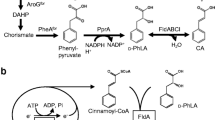Abstract
Loss of substrate, pyruvate, a limitation for enzymatic batch production of (R)-phenylacetylcarbinol (PAC), resulted from two phenomena: temperature dependent non-enzymatic concentration decrease due to the cofactor Mg2+ and formation of by-products, acetaldehyde and acetoin, by pyruvate decarboxylase (PDC). In the absence of enzyme, pyruvate stabilization was achieved by lowering the Mg2+ concentration from 20 to 0.5 mM. With 0.5 mM Mg2+ Rhizopus javanicus and Candida utilis PDC produced similar levels of PAC (49 and 51 g l−1, respectively) in 21 h at 6 °C; however C. utilis PDC formed less by-product from pyruvate and was more stable during biotransformation. The process enhancements regarding Mg2+ concentration and source of PDC resulted in an increase of molar yield (PAC/consumed pyruvate) from 59% (R. javanicus PDC, 20 mM Mg2+) to 74% (R. javanicus PDC, 0.5 mM Mg2+) to 89% (C. utilis PDC, 0.5 mM Mg2+).
Similar content being viewed by others
References
Blume R, Wiechoczek D, Meier H, Wedekind F (1989) Degradation of lactic acid and pyruvic acid in Belousov–Zhabotinskii reactions. Z. Naturforsch. B 44:598–608.
Budavari S, O'Neil MJ, Smith A, Heckelman PE (eds) (1989) Merck Index. An Encyclopedia of Chemicals, Drugs, and Biologicals, 11th edn. Rahway, USA: Merck & Co., Inc., p. 1275.
Chow YS, Shin HS, Adesina AA, Rogers PL (1995) A kinetic model for the deactivation of pyruvate decarboxylase (PDC) by benzaldehyde. Biotechnol. Lett. 17: 1201–1206.
Kimura H (1998) A simple method for the anionic polymerization of ?-carbonyl acids in water. J. Polymer Sci. A Polymer Chem. 36: 189–193.
Rosche B, Breuer M, Hauer B, Rogers PL (2003) Screening of yeasts for cell-free production of (R)-phenylacetylcarbinol. Biotechnol. Lett. 25: 841–845.
Rosche B, Leksawasdi N, Sandford V, Breuer M, Hauer B, Rogers P (2002a) Enzymatic (R)-phenylacetylcarbinol production in benzaldehyde emulsions. Appl. Microbiol. Biotechnol. 60: 94–100.
Rosche B, Sandford V, Breuer M, Hauer B, Rogers P (2002b) Enhanced production of R-phenylacetylcarbinol (R-PAC) through enzymatic biotransformation. J. Mol. Cat. B: Enzym. 19–20: 109–115.
Rosche B, Sandford V, Breuer M, Hauer B, Rogers P (2001) Biotransformation of benzaldehyde into (R)-phenylacetylcarbinol by filamentous fungi or their extracts. Appl. Microbiol. Biotechnol. 57: 309–315.
Shin HS, Rogers PL (1996) Production of L-phenylacetylcarbinol (L-PAC) from benzaldehyde using partially purified pyruvate decarboxylase (PDC). Biotechnol. Bioeng. 49: 52–62.
Zuo Y, Hoigne J (1994) Photochemical decomposition of oxalic, glyoxalic and pyruvic acid catalysed by iron in atmospheric waters. Atmos. Environ. 28: 1231–1240.
Author information
Authors and Affiliations
Corresponding author
Rights and permissions
About this article
Cite this article
Rosche, B., Breuer, M., Hauer, B. et al. Increased pyruvate efficiency in enzymatic production of (R)-phenylacetylcarbinol. Biotechnology Letters 25, 847–851 (2003). https://doi.org/10.1023/A:1024082424066
Issue Date:
DOI: https://doi.org/10.1023/A:1024082424066




